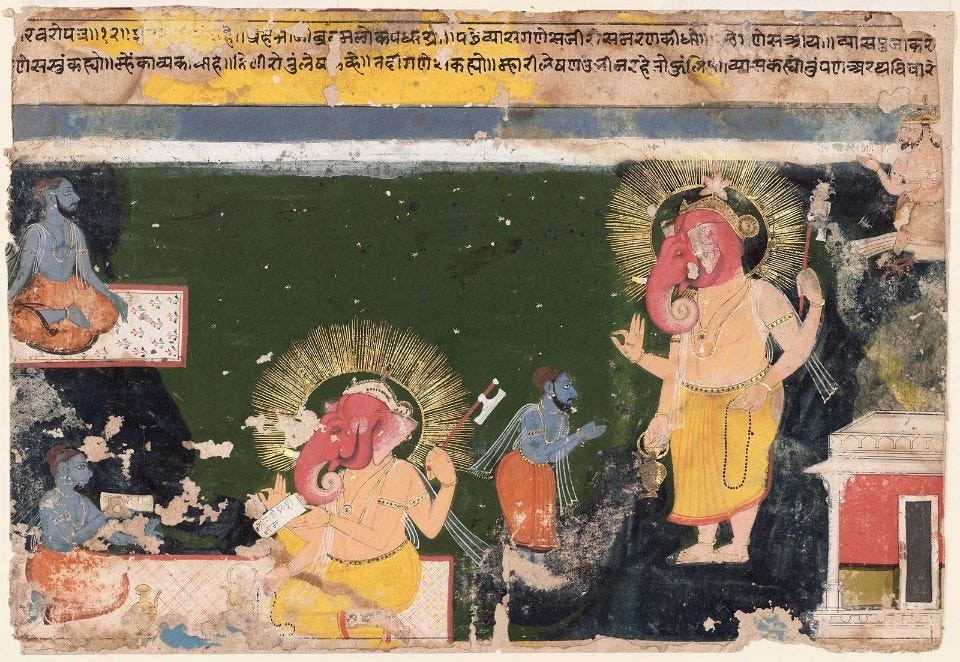Jayary Newsletter #70

Beauty
Brihadasva's recital of Nala and Damayanti's story is meant to act as a salve, but if I were Yudhisthira, it might make me alternately anxious and jealous. Let's look at how the story starts: with a catalogue of Nala's virtues. Nala is a fierce warrior, generous to Brahmins and truthful as they come, but most importantly, his beauty is unparalleled in the world of men.
Similarly, Damayanti is the most beautiful woman in the world. Her eyes, her skin, her figure and her gait are all described as the most sensual thing anyone has ever seen. It's inevitable that such beauties should home in on to each other. Indeed, they fall in love sight unseen because every herald, swan and passing hermit is convinced that the only other person suitable as a husband or a wife to Damayanti and Nala is Nala and Damayanti.
In contrast, Yudhisthira is praised for his kindness, his sense of justice and every once in awhile for his powerful frame. Not once is he described as the handsomest man on earth. In his family, that honour belongs to Arjuna, who's the artist and the star. That's why it's Arjuna who snags Draupadi, the most beautiful woman of her age.
Don't you think that Yudhisthira might feel a pang of jealousy upon hearing of the gravitational pull between Nala and Damayanti and knowing (even if he tries to ignore it) the similar attraction between Arjuna and Draupadi?
The Taming of Love 1
Nala and Damayanti's story is about love. Their story is also about chance. What do the two have to do with each other? Here's a thought: the taming of chance goes hand in hand with the taming of love.
Some people think love makes the world go around. Other's think it's an irrational emotion that's best set aside. There's the possibility that love makes the world go around precisely because it's irrational.
What could make love irrational? The first reason - and the staple of Bollywood movies - one of the lovers is not a suitable candidate because they're too poor, too rowdy or too old for the other person. Usually it's the guy though every once in awhile the powers that be release a movie with a cinderella situation.
In other words, if marriage is a family affair and the rational thing to do is to marry within your social class for the sake of preserving property and status, the irrational thing to do is to marry outside the bounds of social propriety.
The second reason - the Hollywood version of the tale - is when the lovers decide to live together or marry within a few minutes of seeing each other. Especially if they're too young. How young? That depends - Juliet was all of thirteen years old when she fell for Montague's son.
In the modern era, marriage is between individuals, not families. On the other hand, we are supposed to sample the terrain before settling down, and the rational thing to do is to settle with someone who has the same educational level and earning potential. The irrational thing is to make babies when you're sixteen.
In both the familial and individual models of mating, rationality is on the side of risk mitigation, of minimizing the chances of suffering from a bad match.
The Taming of Love 2
There are two ways of mitigating risk. One is to create institutions that manage risk for us. Arranged marriage is a risk management system. Instead of mating being decided by youthful hormones, it's decided by older, less volatile brains. The risk averse shouldn't start a business with their cocaine dealer, so why should they start a business with their oxytocin dealer? Instead, have your family find you a solid boy or girl from your own caste.
Unfortunately, these social institutions are 'local' - they work best when the families are neighbours and have other common social markers such as caste. We moderns don't believe in such localisms. We want universal tools. There's only one universal tool that's been shown to work time and again. You guessed it right: numbers. If social institutions are the drug of the locavores, data is the drug of the cosmopolitans. From shaadi.com to Tinder, love and lust are pawns of zeros and ones.
The shift from social institutions to statistical institutions is the marker of modernity, both in the taming of chance and in the taming of love. Or getting back to our starstruck lovers, Nala and Damayanti act irrationally in falling in love sight unseen. In fact, their love is so irrational that they don't even listen to the gods in doing so. Forget the taming of chance, they flout the dice gods openly. Is it any surprise that their love is tested by Kala - it doesn't fall apart, but who knows, it might have in a different Jaya in a parallel universe - through the act of gambling? It's only when Nala has learned the numerical arts from Rituparna that he can regain his love.


